TrekCore’s Voyager week continues with a trip back to 1996’s “False Profits“, with a special inside look from episode writer George Brozak! Read below as we discuss early concepts for the episode and delaying tactics, then explore some production material and concept art… complete with special archival footage from the filming of the episode!
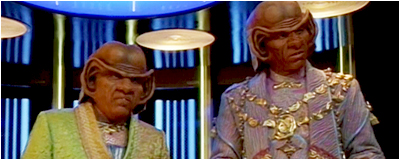
George Brozak: The “False Profits” Interview
Interviewed by Kyle C. Haight
![]()
TrekCore: How did you first get involved with Star Trek, back when you first submitted to The Next Generation?
George Brozak: At that time, The Next Generation was the only television show in Hollywood that had an open “spec script” submission process. I don’t know of another show on television, then or now, that was so forward-thinking. Paramount devised a legal document that you signed and returned with your script; but the caveat was you had to write a full script. You couldn’t just send in a narrative, and you couldn’t just send in a few sentences as you would in a story “pitch” session. The script had to be complete with character dialogue, scene headers, and everything else you would see in a production script. After all, it was your “calling card” of sorts, to show the writing staff what you could do.
And to their credit, if a freelance writer took the time to submit a script, The Next Generation would read it. At the time, I remember the producers and writers stating that they employed “readers”. I don’t know if they were WGA (Writers Guild of America) trainees or interns; but they obviously were well-trained and read the piles and piles of submissions. They would then pass a synopsis report on to the producers.
I remember more than once Ron Moore and others on the writing staff telling me that they also read their fair share of those scripts. Ron has this story that I think he still tells (and I apologize to the writer in advance) of a freelancer who submitted a script called “Tangerine”, and sent it with a carton of tangerines to ensure it would be noticed. So, take it for what it’s worth. I suppose they enjoyed the tangerines, if not the script itself.
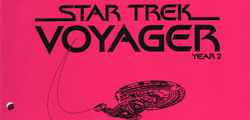 |
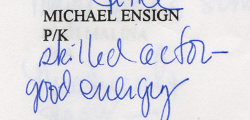 |
| The final script, dated March 15, 1996, along with casting notes which include some now-recognizable names like Brad Garrett, Joshua Malina, and Tony Amendola. |
|
And that was the process. You were in the slush pile, you know, and you had to hope that somebody liked what you wrote, what they read, and that they would take it to the next level. It was an incredible opportunity for many of us, and we owe sincere appreciation to Michael Piller for starting and championing the process, and seeing it through the various incarnations of Star Trek. That’s how I got in the door to be able to pitch what would eventually become a part of “Birthright” (and later, “False Profits” and “Broken Link“).
TrekCore: And they kept that all the way to the end of Voyager, correct?
George Brozak: I believe so; but to be honest, I’m not entirely sure. Once my spec script was brought to the attention of the producers, I no longer submitted through that process. From that point, whenever I had amassed several ideas, I called in and set-up a “pitch session”. For writers, a pitch session is where you tell your ideas, usually in a few sentences, to a producer or member of the writing staff. My very first pitch session was with Jeri Taylor, Ron Moore, and the newly-hired René Echevarria. NO pressure!
TrekCore: Tell us about how you decided to bring back the Ferengi from The Next Generation – Arridor and Kol, from “The Price” – for Voyager’s “False Profits”.
George Brozak: Well, it was a no-brainer for me. I remembered right away that “The Price” had trapped Kol and Arridor at the collapsed end of the Barzan wormhole. Suddenly, one of the most difficult questions — why were two Ferengi in the Delta Quadrant? — was already answered. I didn’t have to contrive a “tech” way to get them there. But the next question was even tougher: Why do we care? What dilemma could the Ferengi present our crew? This is where I had to convince the powers-that-be there was an interesting story to be told. Because just saying “they were there” wasn’t good enough.
 |
|
| Call sheets for March 26, 1996, with a reminder to vote in that day’s primary election. |
Originally, I had conceived Kol and Arridor as much more malevolent, setting themselves up in a “Man Who Would Be King” rule. But unlike the Founders, who conquered quietly and insidiously from within, the Ferengi were really going to be ruthless, brutal taskmasters.
In hindsight, I was trying to change the character of the characters. The writing staff and the producers, who knew much more than me, didn’t see it that way. They felt the Ferengi were at their best when they were blinded by greed. That in turn led them down a devious path, and provided the Trek universe with a comedic outlet. And that’s the tact that they took.
Jeri Taylor called the episode a “wild and crazy romp”. In fact, that was her handwritten note when she sent me a videotape of the final cut episode. I think that change was a better way to go. The Ferengi were already known for being scoundrels. It would have been hard to take them seriously, I think, seeing them like Egyptian whip-masters to the pyramid builders.
This also gave us the chance to put Ethan Phillips in even more makeup, as he transformed from Talaxian to Ferengi. Those of us who watched show knew that Ethan had played a Ferengi on The Next Generation, so for the fans, it was kind of an in-joke to see him back in the Ferengi garb.
Now, did Neelix know the Rules of Acquisition? Was he the worst possible person on Voyager to convince Kol and Arridor that he was a high-ranking official of the Ferengi government? Absolutely. He knew nothing about Ferenginar, or of the Ferengi culture. After all, he was from a different quadrant. I just thought it was a lot of fun to have him in the disguise, like a younger version of the Grand Nagus that we saw on Deep Space Nine. Of course, the Rules of Acquisition weren’t in book form yet!
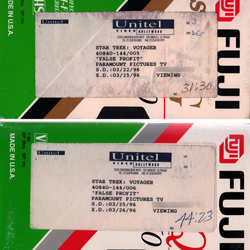 |
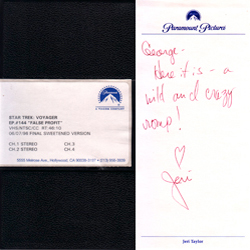 |
| On the left, production tapes of raw footage; on the right, the final version of the episode, complete with Jeri Taylor’s personal touch. |
|
TrekCore: What are your feelings about the ending of “False Profits”? It seemed like Voyager wasted a lot of time when the Barzan wormhole is right in front of them… but they had to wait seven minutes for it, something like that; a lot of time-wasting.
Being the story-writer, not the teleplay-writer, how do you feel about that? Was there ever any real consideration of getting Voyager home at that point?
George Brozak: Again, that’s easy. No. They were never going to get home until the show ended. I think that was pretty clear. If they had gotten home, wouldn’t we just have more of The Next Generation, just on the Voyager sets? I loved Picard and his crew as much as any fan; but I think setting Voyager in a completely new and unexplored territory was key to its DNA. I don’t think the notion of getting them home before the final show of the final season was ever mentioned.
But they always had “carrots”, didn’t they? Always small, fleeting glimmers of hope. “False Profits” had the carrot of, “Here’s a wormhole, we can get home!” In “Eye of the Needle“, we meet a Romulan — another familiar face from the Alpha Quadrant. The wormhole that brought him to the Delta Quadrant can get Voyager home; but then we learn he’s from the past! So here’s yet another carrot and they’ve got another chance to go home. Maybe it’ll work this time. The longing that Harry Kim had was really key throughout the show; he wanted to be home more than anybody, it seemed.
That innate desire, and Janeway’s feeling of responsibility to get her crew home had a special meaning to the fans. Hopefully, there would be a way back. Hopefully, something was going to work. But again, once we got home, the show would be over. And I think the producers dealt with that in an ingenious way: another carrot. The crew is finally able to establish communication “back home”. We can talk to family and friends. We can tell Starfleet what we’ve learned, and what’s coming. We can even share holograms.
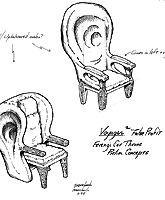 |
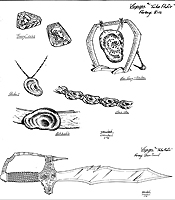 |
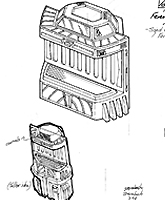 |
| Several of illustrator Rick Sternbach’s concept sketches for props and set pieces | ||
In terms of “False Profits”, my original intent was always for the Ferengi to get home. As is their nature, the Ferengi would sell their grandmother if she made them a profit. And without question, they were going to outwit Voyager, and turn our trust and goodwill to their advantage. They would get to the Alpha Quadrant, not us. And that irony makes the pill harder to swallow. I had this great scene in my mind that moments after emerging from the Alpha Quadrant side of the wormhole, their ship would suddenly be grappled by tractor beam… and on their view screen would appear the image of a Federation starship, and a Starfleet captain asking them to explain themselves!
But Michael Piller didn’t agree with my idea. He thought the greater irony was for the wormhole to whip the Ferengi around, somewhere deeper — somewhere much less profitable. Of course, he was the boss, so that’s how the show ended. I don’t know that it was ever established where they are now; but I know that it was not where they wanted to be.
So, did I think that Voyager took far too long to enter the wormhole? Of course! But even though I knew they weren’t going to go home, we just had to dangle that carrot for them.
Speaking of the producers, I would like to mention the producer that I simply adore to this day: Jeri Taylor. What a wonderful, wonderful woman. She was so compassionate and understanding — so welcoming. She made me feel good about being in the Hart Building, evan as a freelancer. She tried to involve me as much as possible in the process, and invited me to the set to watch filming of the episode. We watched “dailies” in her office the next day. It was an incredible time in my life. To this day, Jeri tells people that I taught her “how to email.” I’m sure she’s giving me too much credit; but it’s still funny to me. Here’s a brilliant producer writing about the voyages of Picard and crew — about amazing, new tech issues onboard the Enterprise — and she wasn’t sure how to email at the time. [Laughs] To be fair, society was just starting to embrace online services at the time — and Jeri was a very fast learner.
I’m so thankful for those email lessons. Jeri and I have maintained a wonderful friendship since those amazing days of Trek, and to this day, we communicate weekly. Jeri and her husband David are enjoying their retirement immensely. Most recently, she bought a new iPad Mini, and just loves it! We sometimes talk about the glory days of Star Trek, and I keep her posted about what her cast and crew members are doing today. I was able to spend several days with Jeri last summer, and that friendship has been, to me, one of the greatest fringe benefits of my joyride with Star Trek.
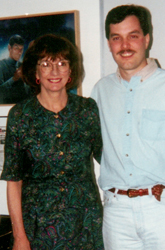 |
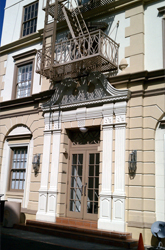 |
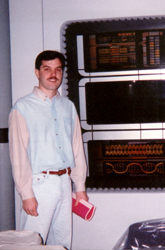 |
| Brozak with Jeri Taylor in the Voyager writers room; the entrance to the Hart Building, which hosted the Trek writers’ offices; exploring the sickbay sets |
||
Again, in hindsight, I wish I had taken the time and opportunity to thank Michael Piller. Those of us who started as freelance writers — including all the wonderful talent he hired to the writing staff (Ron Moore, Brannon Braga, Naren Shankar, René Echevarria… the list goes on) owe a debt of appreciation to Michael. I’m so sorry I didn’t tell him that before he passed away. It’s one of my deepest regrets; but I think of him often.
I also never thanked Ira Behr properly. He saw something in my pitch for “Broken Link”, and wrote a wonderful teleplay for the season cliffhanger. And finally, my heartfelt appreciation to the keeper of the flame, Rick Berman. Because of the hierarchy of Trek at the time, sadly, I never had the opportunity to speak to Rick. His office was not in the Hart Building, and so he didn’t attend pitch sessions. And obviously, he was busier than anyone dealing with the myriad of details it took to create an episode of Star Trek. I wish I had stopped by his office in the Cooper Building, just to say thank you. He deserves more admiration than I can adequately convey.
![]()
In addition to passing along his photos and production documents with us, George also generously shared his tapes of saved “dailies” recordings – containing some wonderful raw, unedited footage from the filming of “False Profits”! Using this extremely rare piece of Trek history, TrekCore is pleased to present this never-before-seen behind-the-scenes footage from the set, which includes a few hilarious outtakes from Ethan Phillips, Robert Duncan McNeill, and Robert Beltran!
Our sincere thanks go to George Brozak for sharing this incredibly rare video with us, and for allowing us to share his story with all of you. Stay with TrekCore as our Voyager week continues!

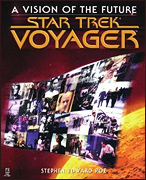 Star Trek: VoyagerA Vision of the Future
Star Trek: VoyagerA Vision of the Future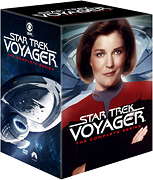 Star Trek: VoyagerComplete Series on DVD
Star Trek: VoyagerComplete Series on DVD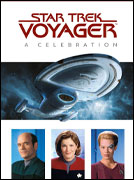 Star Trek: VoyagerA Celebration
Star Trek: VoyagerA Celebration